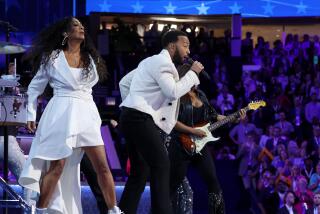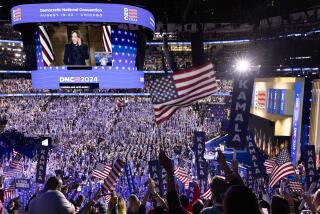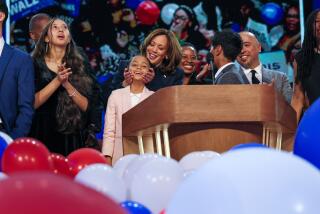A Show of Force Was the Wrong Kind of Show
The racks are bare at your local Winchell’s this week, are they?
All out of glazed at your neighborhood Krispy Kreme?
People, when just about every law enforcement officer south of the Tehachapis seemed to be in downtown L.A. protecting and serving the Democratic National Convention, what do you expect?
There were enough cops for each of the 5,000 delegates to take one home as a souvenir.
There were more cops than at any other convention a veteran political writer and colleague of mine had covered--including the notorious 1968 Democratic convention, where Chicago police were denounced for “Gestapo tactics in the streets of Chicago.”
Police tactics and conduct, as well as exactly what the city spent for this and what it got back, are matters the City Council will review when it returns from recess in 10 days. Report cards on the LAPD vary, sometimes according to who is doing the reporting, friend or foe.
Yet what I heard time and again from among the 20,000 here for the convention was astonishment at the stunning, even intimidating, numbers of police. The massive blue wool wall startled even those it was there to protect. In other countries, “massive police presence” is a code phrase for oppression and intimidation that works by using the threat of baton-swinging and tear-gassing.
As Democrats leave for home today, the last thing L.A. needs for them to pack among their souvenirs is the memory of a city that needs to be wallpapered in cops to keep the peace.
Since the Rodney King and Rampart scandals, police keep pointing out that 99% of officers are honest, honorable and trying to do the right thing. Both city and convention might have come off looking better had the demonstrators been accorded the same kind of percentages. While demonstrators were protesting the corporate conduct of the likes of Banana Republic, downtown Los Angeles looked like a banana republic.
Out-of-towners wouldn’t know this, but it reminded me of the riots of 1992, and the shock of seeing riot-geared LAPD and national guardsmen on the street corners of Los Angeles. Does the city really want to drop the bar so low that the definition of a successful convention is a riot-free convention?
*
Los Angeles’ city officials are scattered far and wide this week. Council member Mike Feuer showed up at Burbank Airport to greet the arriving Al Gore on Wednesday; so did Mayor Riordan, to the possible bewilderment of the mayor of Burbank. Rudy Svorinich, whose San Pedro district was as serene as it is distant from downtown, is on vacation. The telephone at Hal Bernson’s City Hall office was answered Thursday with this: “We will be closed today due to difficulties due to the DNC and will be open tomorrow.” Council President John Ferraro, being treated for spleen cancer, took a brief golf cart ride around the convention site and later said, “I’m sure there will be some Monday morning quarterbacking, but I’m happy Los Angeles got to host the DNC 2000 and become the center of attention for so many people from all over the country.”
But I reached a few--and one reached me.
Council member Alex Padilla came by the L.A. Times Convention Center work space and adjudged the event as “very successful; a lot of [delegates] have never been to L.A. or haven’t been here in a long time, and the misperceptions about the city, traffic, crime, you name it, are totally dispelled. . . . The only thing I think we could have done better is try to engage more residents of the city, especially the taxpayers who made a $4-million investment in the convention.”
Council member Jackie Goldberg rated it a wash. “A lot of delegates came to L.A. and got to see our fair city, and a lot of state and local elected officials got to talk to national officials about West Coast problems. I think the hotels are happy, I think the caterers are in pig heaven, but I think a lot of downtown businesses are disappointed if not miserable. They expected to get a lot of traffic from the convention, and the overwhelming police presence instead made everybody think [downtown] is dangerous.”
And council member Laura Chick praised the restraint of both demonstrators and police, but suggested that the city could have been “a little less fortified, a little less frightened of the democratic process . . . here’s the party of civil liberties and civil rights, and [Los Angeles] is running around preparing for war.”
After the last guest goes, prepare for another kind of war--over the price that L.A. paid for its peace, and what kind of bang the city got for its buck.
*
Patt Morrison’s column appears Fridays. “Crashing the Party,” her video columns from the convention, can be found at www.latimes.com/patt or by finding her work on The Times’ Web site under the heading “Convention features.” Her e-mail address is [email protected].
More to Read
Get the L.A. Times Politics newsletter
Deeply reported insights into legislation, politics and policy from Sacramento, Washington and beyond. In your inbox three times per week.
You may occasionally receive promotional content from the Los Angeles Times.











